It is known that roughly 23 of all human begins have a domin
Solution
Set Up Hypothesis
Null, H0:P=0.667
Alternate, H1: P!=0.667
Test Statistic
No. Of Success chances Observed (x)=77
Number of objects in a sample provided(n)=124
No. Of Success Rate ( P )= x/n = 0.621
Success Probability ( Po )=0.667
Failure Probability ( Qo) = 0.333
we use Test Statistic (Z) for Single Proportion = P-Po/Sqrt(PoQo/n)
Zo=0.62097-0.667/(Sqrt(0.222111)/124)
Zo =-1.0876
| Zo | =1.0876
Critical Value
The Value of |Z | at LOS 0.1% is 1.64
We got |Zo| =1.088 & | Z | =1.64
Make Decision
Hence Value of |Zo | < | Z | and Here we Do not Reject Ho
P-Value: Two Tailed ( double the one tail ) - Ha : ( P != -1.08765 ) = 0.27675
Hence Value of P0.1 < 0.2768,Here We Do not Reject Ho
ANS:
a)
P = x/n = 0.621
It is differ by 0.667 -0.621 = 0.046
b)
H0:P=0.667 , H1: P!=0.667
c)
Z<= -1.64
Z>=1.64
d)
Do not reject the null hypothesis. There s not sufficient evidence to condude that the true proportion of right-leaning behavior differs from 2/3

 Homework Sourse
Homework Sourse